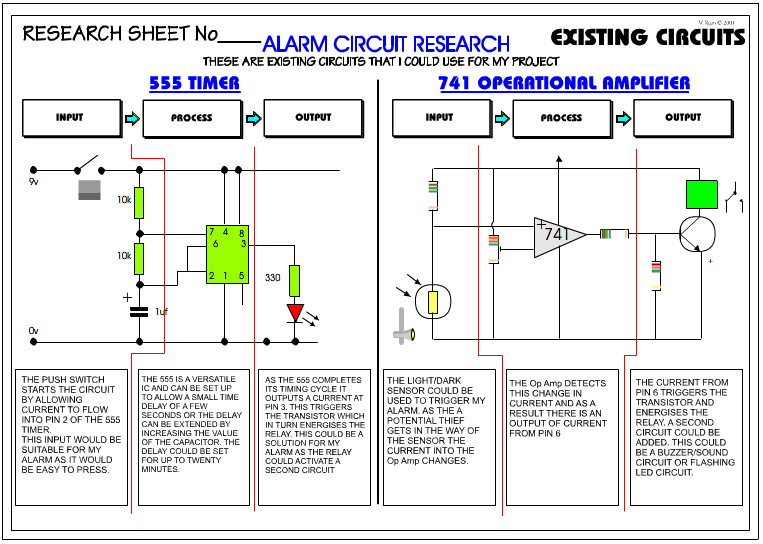| |
| CLICK HERE FOR INDEX PAGE |
| |
| CIRCUIT RESEARCH |
| V. Ryan © 2005 -
2010 |
| |
| (Two Pages) |
| |
|
PDF FILE -
CLICK HERE FOR PRINTABLE CIRCUIT RESEARCH
TEMPLATE |
|
|
|
Circuit research is very important if your are studying
Systems and Control or Electronics. You must show that you have looked at
a range of circuits and components that could be used for your project. A
range of software is available that allows you to build and test circuits
on the screen of a computer and then simulate their operation. Use this
type of software and consider building a temporary circuit using a
breadboard. |
| |
|
Circuit research is very important especially if you are
studying Electronics or Systems and Control. You must show that you have a
clear understanding of INPUT, PROCESS, OUTPUT. Therefore, every time you
draw a circuit clearly break in down into these three aspects. Examples are
shown below: |
| |
|
|
| |
|
Two example circuits are shown below. Notice that for
each circuit the INPUT, PROCESS and OUTPUT are clearly indicated.
1. Draw at least four circuits that
could be used for your project.
2. Your circuits should be complete
with inputs, processes and outputs clearly labelled.
3. Place brief, to the point, notes
underneath each aspect of the circuit.
4. Do not be too concerned with
producing notes in great detail, an overview of each circuit is all that
is needed at this stage.
5. Label components and if your feel
it is necessary explain their function in the circuit.
6. Use circuit simulation software
such as Crocodile Technology and place the printouts on your circuit
research sheets. Your notes should describe how the circuit performed
whilst being simulated on screen.
7. Explain whether or not you think
the circuit is suitable for your project. It may be that only aspects of
the circuit are suitable.
8. You may wish to use three
dimensional drawings of the circuits or ‘real life’ printouts.
Alternatively, you may wish to draw precise circuit diagrams or print
these out directly from electronics software.
9. Use the internet to research
possible circuits. A large range of electronics books are also available.
Photocopies of circuits are acceptable, but remember to make reference to
the book’s title and author.
10. An existing circuit can be adapted
to suit your needs. Look for the circuit that closely matches what you
want and alter its outputs or inputs. |
| |
| |
 |
| |
|
|
|
| |
|
 |
|
|
|
|
|
|
|
SUGGESTIONS:
A. Research using electronics books
and magazines and collect a range of sample circuits
B. Select what you consider to be the
best four circuits and draw them on your circuit research sheets
C. Add brief, clear notes underneath
each INPUT, PROCESS and OUTPUT.
D. Do you consider the circuit usable
for your project?
E. Do not fall behind in your work as
you will find it difficult to catch up later. |
| |
|
| |
|
| CLICK HERE FOR SECOND CIRCUIT
RESEARCH PAGE |
| |
| CLICK
HERE FOR DESIGN PROCESS INDEX PAGE |
| |
| |
| |
|
|
| |

